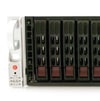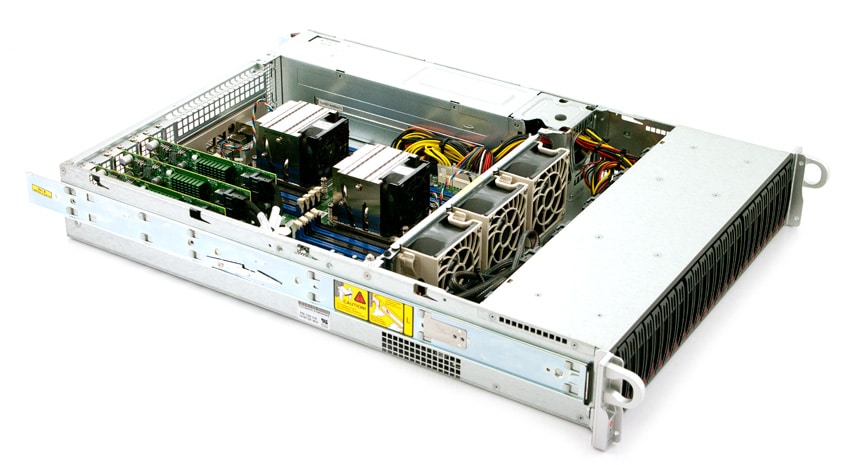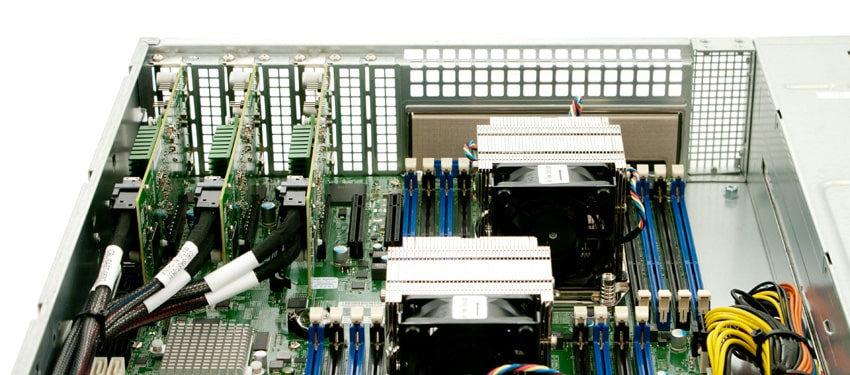 The Supermicro SuperStorage Server AR24NV is a high-end storage system built around leading SAS3 12Gb/s technology. It offers seamless migration from SAS2 to SAS3 for SES-2 layer in terms of storage enclosure management, delivering performance that has the ability to realize the full potential of PCIe 3.0-enabled motherboards and SSD storage solutions. The 2027R-AR24NV is comprised of two main subsystems: the SC216A-R920LPB 2U 24-bay chassis and the Super X9DRH-iF-NV dual-processor serverboard. The main attraction though is an all-new 24-bay SAS3 12Gb/s backplane optimized for the latest generation of SSDs as well as an impressive 7 PCIe 3.0 slots to support a wide range RAID/HBA and networking interconnect options.
The Supermicro SuperStorage Server AR24NV is a high-end storage system built around leading SAS3 12Gb/s technology. It offers seamless migration from SAS2 to SAS3 for SES-2 layer in terms of storage enclosure management, delivering performance that has the ability to realize the full potential of PCIe 3.0-enabled motherboards and SSD storage solutions. The 2027R-AR24NV is comprised of two main subsystems: the SC216A-R920LPB 2U 24-bay chassis and the Super X9DRH-iF-NV dual-processor serverboard. The main attraction though is an all-new 24-bay SAS3 12Gb/s backplane optimized for the latest generation of SSDs as well as an impressive 7 PCIe 3.0 slots to support a wide range RAID/HBA and networking interconnect options.
The Supermicro SuperStorage Server AR24NV is a high-end storage system built around leading SAS3 12Gb/s technology. It offers seamless migration from SAS2 to SAS3 for SES-2 layer in terms of storage enclosure management, delivering performance that has the ability to realize the full potential of PCIe 3.0-enabled motherboards and SSD storage solutions. The 2027R-AR24NV is comprised of two main subsystems: the SC216A-R920LPB 2U 24-bay chassis and the Super X9DRH-iF-NV dual-processor serverboard. The main attraction though is an all-new 24-bay SAS3 12Gb/s backplane optimized for the latest generation of SSDs as well as an impressive 7 PCIe 3.0 slots to support a wide range RAID/HBA and networking interconnect options.

Supermicro has been a frontrunner in the industry with its full range of 12Gb/s SAS 3.0 solutions, which can double storage performance for I/O intensive applications and addresses the growing need for quicker access to data by critical applications as a result of the massive growth of data in cloud and enterprise data centers. Supermicro’s introduction of 12Gbps SAS 3.0 to the server marketplace will also aid customers in creating solutions to intractable data bottlenecks in Big Data/Network Storage, ERP/MRP, Network/Security, and Web Farm/Hosting environments. Supermicro is also actively expanding their server platforms with the latest LSI technologies (LSI 9300-based SAS3 add-on cards) in order to bring maximum levels of performance to enterprise, big data analytics and mission-critical transactional database applications in an accessible, cost effective manner for mass markets.
A further look into the specifications of the 2027R-AR24 shows that it supports the new Nonvolatile DIMM (NVDIMM), which seems to be the growing standard of Supermicro’s server platforms. The most crucial benefit of NVDIMM technology is that it provides a huge amount of persistent DRAM storage, operating at unrivaled speeds and at superior latency when compared to other storage solutions on the market.
The SuperStorage Server 2027R-AR24NV provides an excellent storage solution with the inclusion of Micron as well as the industry’s first end-to-end 12Gb/s SAS3 controllers with both existing HDDs, SSDs, and NVDIMMS. Users will be able to add multiple tiers of high-performance storage into one compact 2U chassis. Additionally, the HD-MiniSAS ports and connections pave way for greater density in smaller form factors creating a seamless deployment.
Supermicro has supplied StorageReview with two servers for the Enterprise Test Lab, with one being built and tested as a Windows Server 2012 R2 file server and the other being a dedicated SAS3 testbed.
SuperStorage Server 2027R-AR24NV Specifications
- CPU:
- Dual Socket R (LGA 2011)
- Intel® Xeon® processor E5-2600 and E5-2600 v2 family (up to 130W TDP)
- Cache: Up to 30MB
- System Bus: QPI up to 8 GT/s
- Memory Capacity
- 16x 240-pin DDR3 DIMM sockets
- Up to 1TB DDR3 ECC LRDIMM
- Up to 512GB DDR3 ECC Registered memory (RDIMM)
- Up to 128GB DDR3 ECC Un-Buffered memory (UDIMM)
- Memory Type
- 1866/1600/1333/1066/800MHz ECC DDR3 SDRAM 72-bit, 240-pin gold-plated DIMMs
- Support ECC and non-ECC UDIMMs
- Supports NV-DIMM Modules
- DIMM Sizes: 32GB, 16GB, 8GB, 4GB, 2GB, 1GB
- Memory Voltage: 1.5 V, 1.35 V
- Chipset: Intel® C602 Chipset
- AHCI SATA:
- SATA2 (3Gbps) with RAID 0, 1, 5, 10
- SATA3 (6Gbps) with RAID 0, 1
- SCU SATA: SATA2 (3Gbps) with RAID 0, 1, 10
- Network Controllers:
- Intel® i350 Dual Port GbE
- Virtual Machine Device Queues reduce I/O overhead
- Supports 10BASE-T, 100BASE-TX, and 1000BASE-T, RJ45 output
- 1x Realtek RTL8201N PHY (dedicated IPMI)
- Graphics: Matrox G200eW
- AHCI SATA:
- 2x SATA3 (6Gbps) ports
- 4x SATA2 (3Gbps) ports
- SCU SATA
- 4x SATA2 (3Gbps) ports
- SAS
- 24x SAS3 (12Gbps) ports
- LAN
- 2x RJ45 GbE ports
- 1x RJ45 Dedicated IPMI LAN port
- USB
- 4x USB 2.0 ports total (4 rear)
- VGA
- 1x VGA port
- Serial Port / Header
- 2x Fast UART 16550 serial COM port (1 rear & 1 header)
- Chassis
- Form Factor: 2U Rackmount
- Model: CSE-216BAC-R920LPB
- Dimensions
- Width: 17.2″ (437mm)
- Height: 3.5″ (89mm)
- Depth: 25.5″ (647.7mm)
- Gross Weight: 61 lbs (27.7 kg)
- PCI-Express:
- 1x PCI-E 3.0 x16 slot
- 6x PCI-E 3.0 x8 slots (slots 1, 2, & 3 are populated by default)
- Drive Bays
- Hot-swap: 24x Hot-swap 2.5″ SAS3/SATA3 HDD Bays
- Backplane: SAS3/SATA3 Direct Attached Backplane
- Fans: 3x 80mm 7000 RPM PWM fans
- 920W high-efficiency AC-DC Redundant power supplies with PMBus and I2C
- AC Input: 100-240 V, 50-60 Hz, 11-4.5 Amp
- DC Output:
- 4 Amp @ +5V standby
- 75 Amp @ +12V
- With Power Distributor:
- +5V: 45 Amp
- +3.3V: 24 Amp
- -12V: 0.6 Amp
- Operating Temperature: 10°C to 35°C (50°F to 95°F)
- Non-operating Temperature: -40°C to 60°C (-40°F to 140°F)
- Operating Relative Humidity: 8% to 90% (non-condensing)
- Non-operating Relative Humidity: 5% to 95% (non-condensing)
SuperStorage Server 2027R-AR24NV Specifications (Windows Server 2012 R2 Fileserver)
- 2 x Intel Xeon E5-2620 (2.0GHz, 15MB Cache, 8-cores)
- Intel C602 Chipset
- Memory – 32GB (4 x 8GB) 1333Mhz Micron DDR3 Registered RDIMMs
- Windows Server 2012 Standard R2
- 2 x Adaptec 81605ZQ SAS3 RAID Card
- 2 x 480GB Seagate SSD 600 in RAID1 (boot)
- 8 x 960GB Micron M500 in RAID50 (storage tier 1)
- 16 x 600GB 10K SAS in RAID60 (storage tier 2)
- Micron RealSSD P420m 1.4TB PCIe SSD (storage tier 0)
- 2 x Mellanox ConnectX-3 Dual-Port VPI PCIe 3.0 Adapter
SuperStorage Server 2027R-AR24NV Specifications (SAS3 Testbed)
- 2 x Intel Xeon E5-2687 v2 (3.4GHz, 25MB Cache, 2-cores)
- Intel C602 Chipset
- Memory – 256GB (16 x 16GB) 1333Mhz Micron DDR3 Registered RDIMMs
- Windows Server 2012 Standard – 100GB Micron RealSSD P400e Boot SSD
- 3 x Supermicro SAS3 HBAs (LSI SAS 3008 Controllers)
- 100GB Micron P400e Linux CentOS 6.3 boot
- 200GB Micron P400m Windows Server 2012 boot
- 100GB Micron P400e Linux CentOS 6.3 boot (Sysbench) w/ Micron M500 960GB for Database storage
- Mellanox ConnectX-3 Dual-Port VPI PCIe 3.0 Adapter
Design and Build
Supermicro’s SC216 chassis makes the most out of storage capacity in a 2U form factor by equipping itself with twenty-four hot-swappable 2.5″ SAS/SATA hard drive bays for applications that need extra storage. The design of the SC216 also optimizes its interior space without compromising cooling capabilities. The chassis is also built with a redundant and efficient power supply for greater efficiency as well as optimized cooling and seven low-profile or UIO solution expansion slots for better networking options. Additionally, with its quick release, tool-less slide rails functionality, installation of drives is quick and easy.

On the front panel of the chassis, you will see the twenty-four 2.5″ drive bays. Hard drives or SSDs must be purchased separately. To remove the drive carriers from the chassis, press the release button on the drive tray to extend the drive bay handle. Use the handle to gently pull the tray out of the chassis. The hot-swap capable carriers can be removed without powering down the system. To install a drive, simply secure the drive to the carrier with four screws and slide the carrier into an open slot in the chassis.
Also visible on the front are several buttons and LEDs to indicate the status of the system. The two push-buttons are a power on/off button and a reset button while the following LEDs serve as indicators for the following:
- Power: Indicates power is being supplied to the system’s power supply units. This LED should normally be illuminated when the system is operating.
- HDD: Indicates IDE channel activity and will blink when there SAS/SATA drive and/or DVD-ROM.
- NIC2: Indicates network activity on GLAN2 when flashing.
- NIC1: Indicates network activity on GLAN1 when flashing.
- Power Failure: When blinking, this indicates a power failure in the powersupply.
- Information LED: Alerts user of several system states
The rear of the SC216 chassis includes the following features left to right. The chassis includes two high-efficiency redundant 920W power supplies. Supermicro also offers an optional BBP (Battery Backup Power) that can take the place of one power supply and offer integrated power-backup in the event of a power failure. Next to the power supplies is an optional two-bay boot drive kit, which lets you relocate two SSDs or HDDs to the rear panel instead of using one of the front 24 bays. Next is the motherboard (Super X9DRH-iF-NV) backplane, which includes serial and VGA out, as well as four USB ports, a dedicated management LAN port and two 1GbE LAN ports. The remaining ports are from expansion cards in the seven half-height PCIe slots.

To remove the chassis cover, simply press both release tabs to at the same time to unlock it, then slide the cover toward the rear of the chassis and lift the cover off the chassis. Once the chassis is open, three 80mm 7000 RPM PWM fans are visible that keep the twenty-four drive bays, motherboard, and add-on cards cool. Also visible is the air shroud to funnel air directly to where it is needed.
Looking towards the front of the chassis, the very unique backplane is visible with direct connections to each of the 24 HDDs or SSDs. The HD-MiniSAS ports and connections makes for greater density in smaller form factors for ease of deployment and best performance, which is a very important feature for us.

In the center of the chassis is the Super X9DRH-iF-NV dual-processor serverboard, which has Dual Intel E5-2600 (V2) Series (Socket R) processors visible; each processor supports two full-width Intel QuickPath Interconnect (QPI) links. You will also see an Intel I350 1-Gigabit Ethernet Dual-Channel controller for LAN1/LAN2 ports as well as the Nuvoton BMC Video Controller (Matrix E200) GPU.
The heatsinks on the X9DRH-iF-NV are both active and passive. To optimize for best cooling performance and reduce power consumption, Supermicro uses a passive heatsink closest to the chassis cooling fans and an active fan towards the back of the chassis where air pressure is lower.
For expansion slots, the serverboard has an impressive six PCIe 3.0 x8 slots as well as a longer PCIe 3.0 x16 slot. Because the PCIe 3.0 x8 slots are all open ended, you can install x16 PCIe devices and have them run in x8 mode. You can also clearly see that Supermicro’s made sure that the area behind the PCIe slots are relatively vacant so users can easily add more bulky cards.
Management
The Supermicro Update Manager (SUM) remotely updates the BIOS and system settings of SuperStorage Server 2027R-AR24NV using OOB (Out-Of-Band) communication channels. Users can remotely edit system BIOS settings from a readable text file to update the target machine’s system BIOS configuration. BIOS updates and setting operations are independent of operating environments and thus can be executed before system OS/hypervisor is installed.
Key features of SUM include:
- Update BIOS ROM
- Get/Set BIOS settings
- Get/Set SMBIOS/DMI
- Mass Deployment
- Check HW/FW support for OOB management
- Activates product keys to enable OOB BIOS management feature
Users have the choice of choosing between In-band and OOB methods. The In-band mechanism method issues commands locally from CPU, required no product key for BIOS updates and supports RHEL 6.3 and Ubuntu 12.04. The OOB mechanism is independent of OS Kernel/Distribution/Hypervisor. Additionally, it can change BIOS parameters before OS installation, has no current BIOS dependency, and recovers servers from corrupt BIOS allt he while not affecting CPU utilization.
The ATEN BMC firmware 3.17 update (and above) has included security enhancements that prevents unwarranted intrusions via Shell injections, Buffer overflows, and Man-in-Middle attacks.
Conclusion
The Supermicro SuperStorage Server 2027R-AR24NV gives early-adopting IT admins a platform that provides access to waves of new storage technology like SAS3 interface SSDs and emerging NVDIMM technology. Both storage options proffer some of the latest technology designed to offer high-throughput, low latency transactions to the most demanding applications. Of course the motherboard also supports 7 PCIe slots that allow for flexibility from both a storage and high-speed interconnect perspective alike.
The StorageReview lab is currently deploying twin SuperStorage Server 2027R-AR24NV platforms. The first is in use as a primary file server, leveraging a combination of eight Micron M500 SSDs, Micron PCIe storage and sixteen 600GB 10K SAS HDDs. The combination of the three storage tiers within a single box provides tremendous throughput for high-demand VMs and reliable access to lower-cost storage on the HDD tier. For SAS3 testing the Supermicro platform a leading option on the market for those who want the promise of SAS3 throughput out of SSDs today, without waiting for major server vendors to support such things months from now. The use cases get even more compelling for those wanting to reach into even more fringe waters with the support for NVDIMM.
Long term the Supermicro configurations will feature in many upcoming reviews, handling everything from single SAS3 SSD benchmarking to testing of much larger arrays in a wide variety of enterprise application benchmarks.
Discuss This Review
